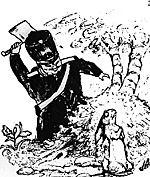 During the Wars of the French
Revolution and of the Empire, as
hunting was reserved to the privileged
few, the forests of Europe, and
especially Germany where most of the
campaigns of the period took place,
were well stocked with a wide variety
of game ranging from pheasants,
partridges, quails, rabbits, and hares to
the larger wild boar and deer.
During the Wars of the French
Revolution and of the Empire, as
hunting was reserved to the privileged
few, the forests of Europe, and
especially Germany where most of the
campaigns of the period took place,
were well stocked with a wide variety
of game ranging from pheasants,
partridges, quails, rabbits, and hares to
the larger wild boar and deer.
Rabbits were by far the most available game. We should realize that, in our period of interest, poaching had been practiced by the French country folk for generations (and still is) as a means of improving theirdiet. The practice started simply because hunting was strictly reserved to the local nobles and obviously they needed all the available game in the first place. Here we were dealing with survival.
Wild rabbits (called in France lapins de garenne) are always plentiful as the species is prodigiously fertile. In addition, they are relatively easy to catch with a simple sliding collar made of any metallic wire called in France collet (i.e. snare or noose). This was a technology at which practically every young soldier from the countryside or farm was an expert.
The snare is simply placed at the right height on the narrow paths that wild rabbits always follow to move around their feeding grounds. These paths are easy to spot to the trained eye, as rabbits never miss to mark them with their droppings. So, snares placed in the evening can be harvested early in the morning and voila, food for the day!
Of course some soldiers may have preferred to shoot a rabbit like other game, but that was a noisy procedure.
Skinning a rabbit is an easy task
[2] and was commonly practiced
by country boys.
How did the Napoleonic soldier
prepare his rabbit?
There are several simple ways
to cook a rabbit well within the
cooking ability of our soldiers. The
easiest way is to barbecue it over a
wood fire. A rabbit cooked on a spit
always tastes good. [3]
Obviously on many occasions,
the unfortunate rabbit was simply
added to the soup without other
formality and provided additional meat.
More Leona's Corner
[2] In France as well as the rest of continental Europe,
raising domestic rabbits for food is a common and easy procedure in the countryside. In
our family, we raised rabbits during WWII and skinning was part of the process.
This article appears in MagWeb (Magazine Web) on the Internet World Wide Web.
Napoleon's Coronation and the Imperial Family
The Napoleonic Soldier and Game
My Preferred Way of Cooking Rabbits
Footnotes
[3] Many modern gastronomes insist that roasting
must be done over a wood and not a coal fire. So, perhaps, our Napoleonic soldier may have
been a gourmet cook without knowing it.
Back to Empire, Eagles, & Lions Table of Contents Vol. 2 No. 9
Back to EEL List of Issues
Back to MagWeb Master Magazine List
© Copyright 1994 by Emperor's Headquarters
Other military history articles and gaming articles are available at http://www.magweb.com
